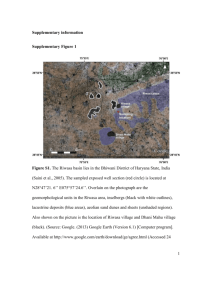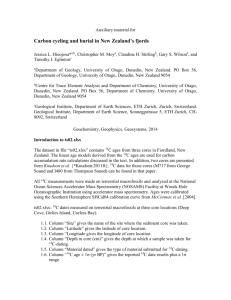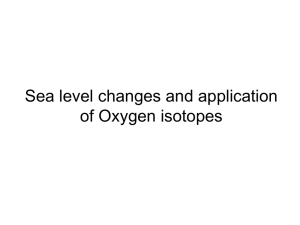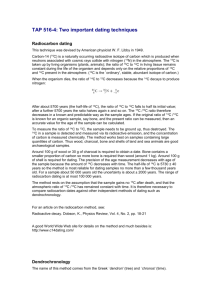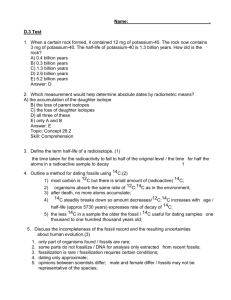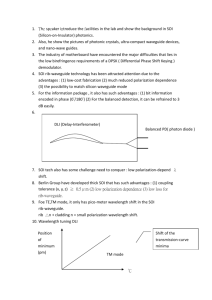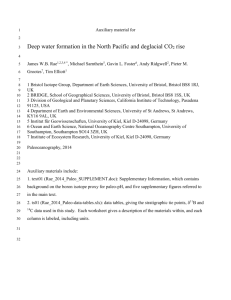grl52650-sup-0001-Supplementary
advertisement
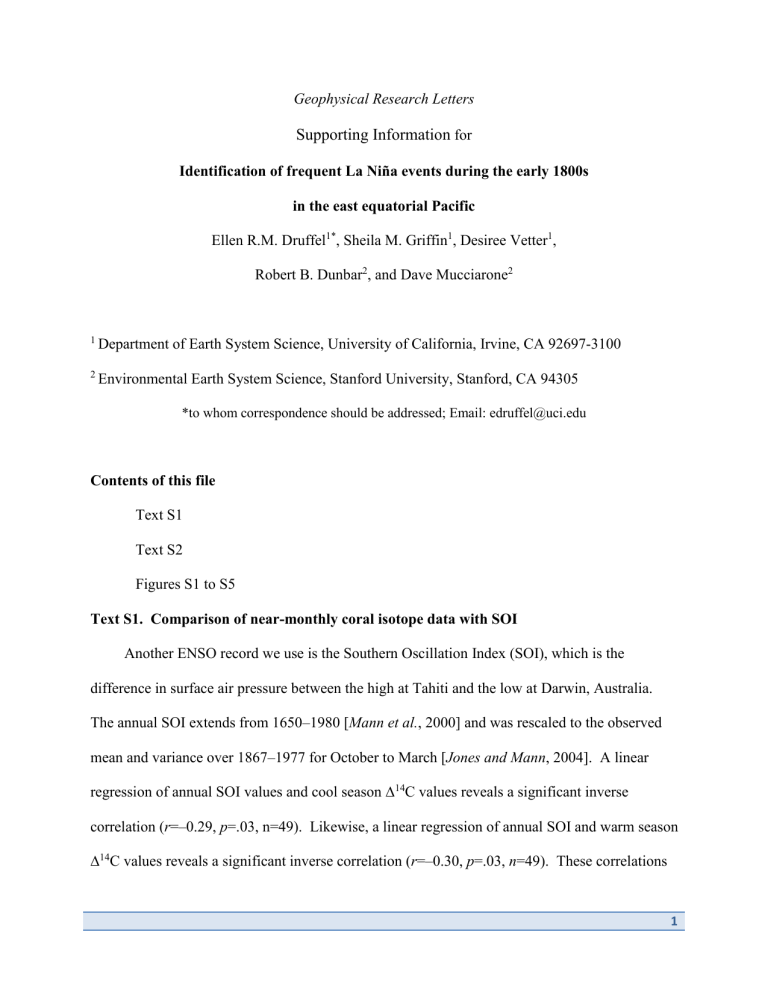
Geophysical Research Letters Supporting Information for Identification of frequent La Niña events during the early 1800s in the east equatorial Pacific Ellen R.M. Druffel1*, Sheila M. Griffin1, Desiree Vetter1, Robert B. Dunbar2, and Dave Mucciarone2 1 Department of Earth System Science, University of California, Irvine, CA 92697-3100 2 Environmental Earth System Science, Stanford University, Stanford, CA 94305 *to whom correspondence should be addressed; Email: edruffel@uci.edu Contents of this file Text S1 Text S2 Figures S1 to S5 Text S1. Comparison of near-monthly coral isotope data with SOI Another ENSO record we use is the Southern Oscillation Index (SOI), which is the difference in surface air pressure between the high at Tahiti and the low at Darwin, Australia. The annual SOI extends from 1650–1980 [Mann et al., 2000] and was rescaled to the observed mean and variance over 1867–1977 for October to March [Jones and Mann, 2004]. A linear regression of annual SOI values and cool season ∆14C values reveals a significant inverse correlation (r=–0.29, p=.03, n=49). Likewise, a linear regression of annual SOI and warm season ∆14C values reveals a significant inverse correlation (r=–0.30, p=.03, n=49). These correlations 1 indicate that a high SOI (strong southeast trade winds) occurs when upwelling is strong in the EEP (low ∆14C), and that a low SOI (weak winds) occurs when upwelling is weak or absent (high ∆14C). A linear regression of annual SOI and cool season 18O values yields a positive correlation (r=.30, p=.03, n=50). Additionally, annual SOI and warm season 18O values are positively correlated (r=.49, p=.0003, n=49). These results show that cool season 18O values are high (low SST) when southeast trade winds are strong (high SOI), and low (high SST) when winds are weak or absent, e.g. during El Niño. It appears that both cool and warm season ∆14C and 18O values are correlated with the annual SOI, which is an indicator of ENSO (both La Niña and El Niño phases). These results agree with correlations in our calibration study for this coral between near-monthly ∆14C and 18O [Druffel et al., 2014] with a monthly SST Niño 3.4 record [Kao and Yu, 2009]. Text S2. Comparison of near-monthly coral isotope data with PDO record of Biondi et al. (2001) The annual PDO index is available for the period AD 1661-1991 using tree ring chronologies [Biondi et al., 2001]. A linear regression of this annual PDO index and cool season ∆14C values from 1783-1835 yields a positive correlation (r=0.31, p=.02, n=52). This agrees with our analysis using the PDO record of MacDonald and Case (2005) [MacDonald and Case, 2005]. A positive correlation was also obtained for a linear regression of the annual PDO and warm season ∆14C values between 1783 and 1835 (r=0.39, p=.003, n=53). The annual PDO index and cool season 18O values from 1783–1835 is negatively correlated (r=–0.29, p=.03, n=51), again agreeing our analysis using the PDO record of MacDonald and Case (2005). 2 Figure S1. Seasonal Galapagos coral ∆14C (black circles), 18O (black open circles) and 13C (grey circles) measurements for (a) 1602-1611, b) 1637-1647, and (c) 1783-1835. Annual bands were assigned mainly using 13C seasonality. These band assignments are 2 years later in bands older than 1799, compared to those made previously [Druffel et al., 2007; Dunbar et al., 1994], based on the seasonal 13C values in the period 1790-1800. Figure S2. Annual tree ring ∆14C [Stuiver et al., 1986] (open circles) and seasonal Galapagos coral ∆14C values (filled circles) for (a) 1602-1611, (b) 1637-1647, (c) 1783-1835. Figure S3. Seasonal Galapagos coral ∆14C (black circles), and 18O (black open circles) measurements for (a) 1783-1805, and (d) 1806-1835. Cool season ∆14C and 18O values are blue open circles, and warm season ∆14C (18O) values are red circles. These cool and warm season values are used in Sections 4.3 and 4.4 of the text for comparison with climate indices. Figure S4. Wavelet spectral density of the ∆14C and 18O records (interpolated to 12 or 13 measurements per year) from coral bands from 1602-1611 (a,b), 1637-1647 (c,d), and 1783-1835 (e,f), respectively. The greyness scale shows that 75%, 50%, 25% and 5% of the wavelet power is above each level (white, grey, dark grey, darkest grey), respectively. The black lines show the 20% significance level using a red-noise (autoregressive lab 1) background spectrum. The crosshatched region is the cone of influence where boundary effects are significant [Torrence and Compo, 1998]. 3 Figure S5. Cross spectral analyses [Howell et al., 2006] of the ∆14C and 18O measurements from the time periods (a) 1602-1611, (b) 1637-1647, (c) 1783-1835, and iterative cross spectral analyses of these measurements from the time periods d) 1783-1800, e) 1800-1818, and f) 18181835. 4 Figure S1a,b,c. (a) (b) (c) 5 Figure S2a,b,c. (a) (b) (c) 6 Figure S3a,b. (a) (b) 7 Figure S4a,b,c,d,e,f. (a) (b) (c) (d) (e) (f) 8 Figure S5a,b,c. (a) (b) (c) 9 Figure S5d,e,f. (d) (e) (f) 10 References Biondi, F., A. Gurshenov, and D. Cayan (2001), North Pacific Decadal Climate Variability Since AD 1661 Journal of Climate, 14(1), 5-10. Druffel, E., S. Griffin, S. Beaupré, and R. Dunbar (2007), Oceanic climate and circulation changes during the past four centuries from radiocarbon in corals, Geophysical Research Letters, 34, doi:10.1029/2006GL028681. Druffel, E., S. Griffin, D. Glynn, R. Dunbar, D. Mucciarone, and J. Toggweiler (2014), Seasonal radiocarbon and oxygen isotopes in a Galapagos coral: Calibration with climate indices, Geophys. Res. Lett., 10.1002/2014GL060504. Dunbar, R. B., G. M. Wellington, M. W. Colgan, and P. W. Glynn (1994), Eastern Pacific sea surface temperature since 1600 A.D.: The d18O record of climate variability in Galapagos corals, Paleoceanography, 9, 291-315. Howell, P. J., N. Pisias, J. Ballance, J. Baughman, and L. Ochs (2006), ARAND Time-Series Analysis Software, edited, Brown University, Providence, RI. Jones, P., and M. Mann (2004), Climate over past millennia, Reviews of Geophysics, 42(RG2002), doi:10.1029/2003RG000143. Kao, H.-Y., and J.-Y. Yu (2009), Contrasting Eastern-Pacific and Central-Pacific Types of ENSO, Journal of Climate, 22, 615-632. MacDonald, G., and R. Case (2005), Variations in the Pacific Decadal Oscillation over the past millennium, Geophys. Res. Lett., 32, 10.1029/2005GL022478. Mann, M., E. Gille, J. Overpeck, W. Gross, R. Bradley, F. Keimig, and M. Hughes (2000), Global temperature patterns in past centuries: An interactive presentation, Earth Interact., 4, Available at http://EarthInteractions.org. Stuiver, M., G. W. Pearson, and T. Braziunas (1986), Radiocarbon age calibration of marine samples back to 9000 cal yr BP, Radiocarbon, 28(2B), 980-1021. Torrence, C., and G. Compo (1998), A Practical Guide to Wavelet Analysis, Bull. Amer. Meteor. Soc., 79, 61-78. 11



